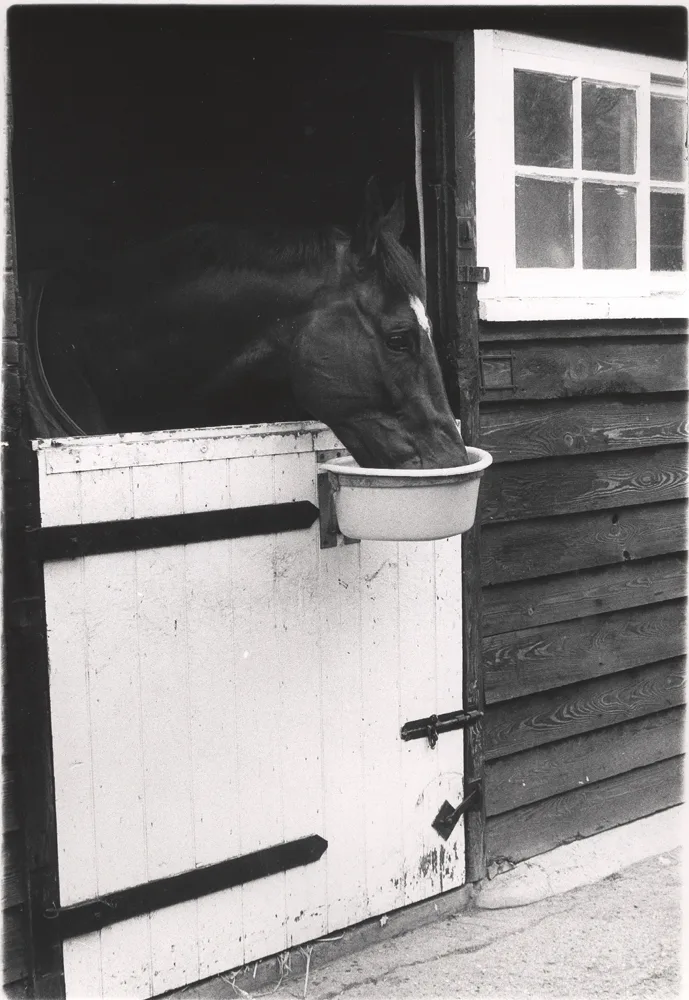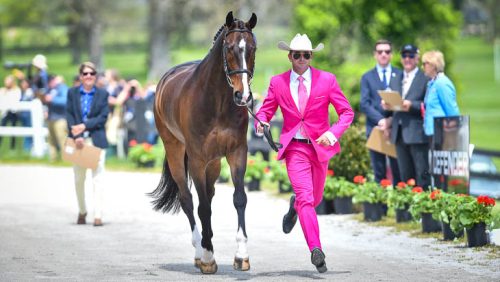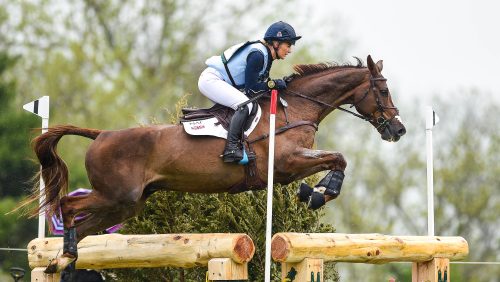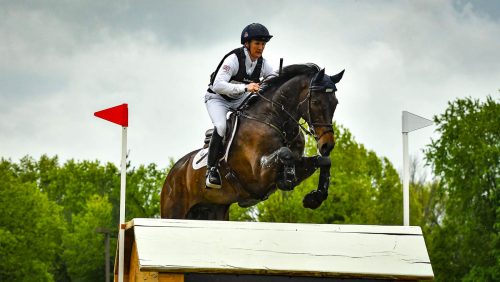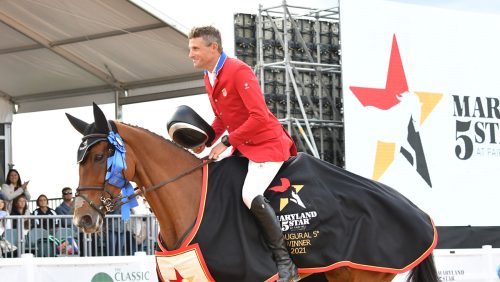This article appeared in the June 18, 1965 issue of The Chronicle of the Horse…
Lambourn, Berkshire, where Fred Winter trained Jay Trump for the Grand National and where, for the past ten months Crompton ‘Tommy’ Smith, Jr. and his bride, Frances, have been living is (after Newmarket and Epsom) the most famous training center in England.
Lambourn lives horses. The official Sporting Chronicle of the Horses in Training, 1965, lists 17 yards(stables) housing about 1,000 horses, roughly one horse to every third person in the village.
Mornings the main street reverberates with the sound of hooves, as strings of horses file singly along the tarmac, past thatched roofed Shakesperian cottages bordered with flowers, en route to their morning’s work on the Downs.
Here on a sea of grass like our western prairie, waves of lush green staked out into furlongs by moveable orange marker discs, are the gallops—the chalk Downs that never become too heavy and on which horses may work all year around. They are unique to Britain, and to ride out over that wind-swept on which the Danes, the Romans, and Charles I (fleeing from Cromwell) made tracks unforgettable.
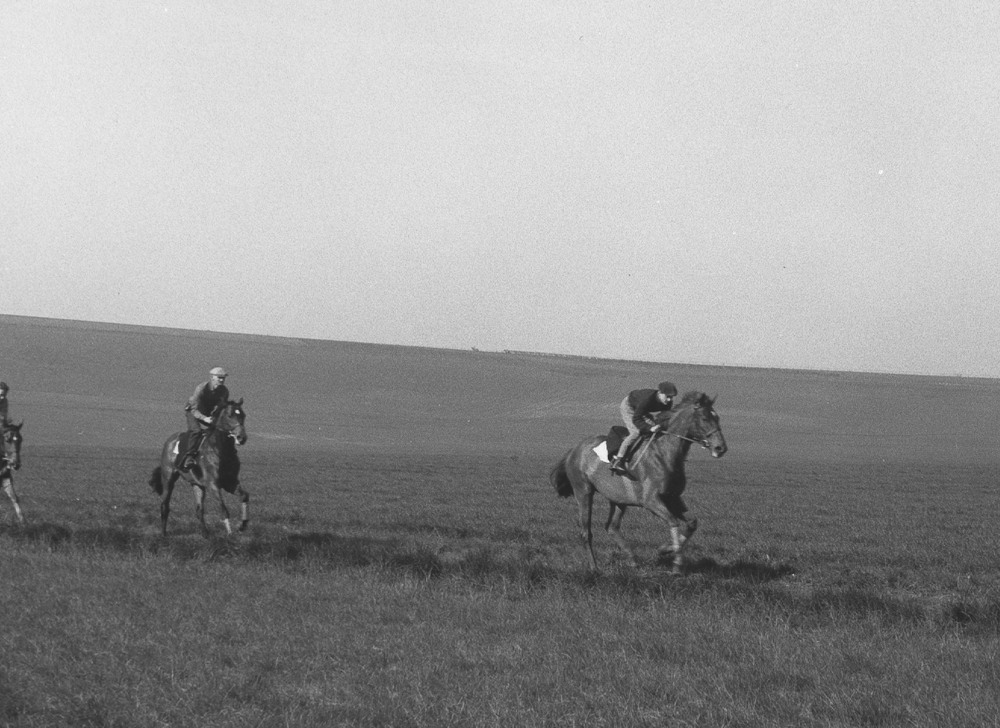
The gallops at Lambourn. Photo by McClary
The horses that have trained here are legion. Battleship was ridden out of Reginald Hobbs’ cobbled yard (now owned my M. W. Feakes). In recent times Mill House has produced the great Madarin, which trainer Fulke Walwyn rides at the head of his string, and the last three Grand National winners, Ayala, Team Spirit and Jay Trump.
During the months they spent in Lambourn the American horse and his American rider came to be exhibit A. They were as American as the Stars and Stripes that were borrowed from a nearby Army Base to be hung up in Trainer Winter’s yard to commemorate the All American victory at Aintree.
ADVERTISEMENT
At first Lambourn didn’t know what to make of Mrs. Mary C. Stephenson’s big bay horse with his powerful caterpillar-like canter (paradoxically the word gallop is never used on the gallops) and his amateur rider in his distinctive American garb—Middleburg Reliable Store corduroys, worn Newmarket boots and rolled brim cowboy Stetson. Fred Winter’s efforts to persuade Tommy to wear ‘jods’ like his stable lads and not destroy the symmetry of the string were to no avail. When winter came the trainer thought he had it made. “It’s too cold to wear light trousers,” he said. The next morning Tommy, to whom jodhpors are uncomfortable, appeared in two pairs of corduroys.
“Co’er,” said one of the lads. “The first time I seen him ride out I thought he was a bloomin’ shephard!”

Tommy Smith riding out on Jay Trump in his All-American outfit that was the talk of the English gallops. Photo by McClary
In the British racing fraternity there is a certain amount of friendly rivalry between professionals and amateurs. To say that a jockey looks like a real amateur or that a horse would make a good ride for an amateur is not considered a compliment.
The first morning Tommy rode out with Fred Winter’s string he was thrown up onto a ’chaser called Anglo. Instead of sitting down and picking up his reins as they do in England, he stood up to test his stirrups as they do in America. Anglo, released by the lad holding him, went up into the air and Tommy went out the front door.
“I lay on my back looking up at that ring of faces,” Tommy says. “I knew what they were thinking. He’s a real amateur, he is.”
It wasn’t until Jay Trump’s first school over fences that the talent that had won him America’s top timber races became apparent.
In England chasers are rarely schooled between races and never alone. British Park fences stand a regulation 4’6″ and are built of hard-packed birch. Although they look like our brush they cannot be brushed through. A “bash over the sticks” means just that. Over, not through. They are almost as stiff as our timber. But there the resemblance stops. What self respecting hunter and timber horse has seen the vast expanses of water and awesome open ditches?
ADVERTISEMENT
It is understandable that Fred Winter was skeptical when Tommy suggested schooling Jay Trump alone. He pointed out that on that particular morning he did not have a horse to go out with him. “That’s all right,” Tommy replied. “But how do you know he’ll jump alone?” the trainer asked. “He’ll do whatever I tell him to do,” replied his rider. Then, to the astonishment of all concerned, he proved his point by persuading Jay Trump to two-track along the Gallops and do a forehand turn.
At the brow of the Downs there are a series of schooling fences, small, medium, large and largest. Tommy, in corduroys and cowboy hat, circled The Trump and sent him into the highest of the fences. Jay Trump cocked his ears, observed the unfamiliar obstacles and without hesitation, sailed over the course.
A week later Jay Trump ran in the Autumn Trial Chase at Sandown Park. His chances of winning his first British steeplechase over the unfamiliar course were given little consideration. Sandown was to be a prep for Becher Chase later on at Liverpool where it was hoped the American color-bearer, who would be fitter and more acclimatized, might possibly win the 500 pounds that would make him eligible for entry in the Aintree Grand National.
Walking his first course with Fred Winter was Tommy’s formal indoctrination to a phase of racing which Britain’s four-time champion jockey has raised to a fine art. After riding 4000 races in the 17 years, Fred, the most popular and successful steeplechase jockey in modern times (the lads in his yard call him “The Honorable Fred”) knows the ups and downs of every course in England. As he had turned trainer but six months previously he was thinking in terms of how he himself would ride the course.
However Fred says that he did not give Tommy detailed instructions. “He has plenty of experience and didn’t need them. The only thing I impressed upon him was not to drop back too far!”
The problem turned out to be not letting Jay Trump get too far ahead over the water and wide ditches he had not jumped before. At the end there was no holding the horse back as he went on to clear the last two fences on his own as brilliantly as he had jumped the third fence in Maryland.
By the time the Smiths and Jay Trump left Lambourn for France they had proved themselves better ambassadors than a host of striped pant diplomats. The town turned out to give them a farewell dinner and present them with a silver platter on which the signatures of their friends had been engraved. And Tommy Dearie, a former jockey who nightly serves the lads their lager in his Malt Shovel Pub at the foot of Malt Shovel Lane, had added an autographed picture of Jay Trump to the roster of famous Lambourn horses on the walls and was planning the customary thrash (party) that is held whenever a local horse wins a classic race.
When asked why he thought Jay Trump had a chance in the Grand Steeplechase de Paris June 20th, Dearie replied “The horse can do most anything. He proved that, didn’t he now?”
Jay Trump won the Maryland Hunt Cup in 1963, ’64 and ’66. In the fall of 1964, he shipped to England to train with Fred Winter and in 1965, he won the famed English Grand National, becoming the first American-owned, -bred and -ridden winner of the Grand National. He finished third in the Grand Steeplechase de Paris, then shipped home to the United States. His 1966 Maryland Hunt Cup win was his last; he retired just after the race. The author of this story, Jane McIlvain, wrote the book The Will To Win: The True Story Of Tommy Smith And Jay Trump.

